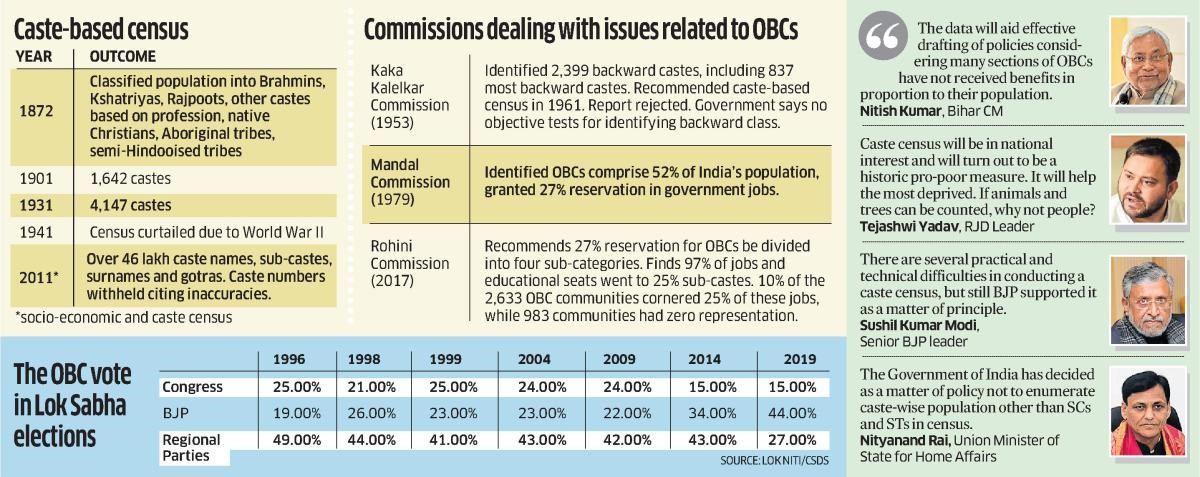Caste Census
Figure 1: No Copyright Infringement Intended
Context:
- SEVENTEEN Muslim organisations, under the umbrella of All India Pasmanda Muslim Mahaz demanded a caste census for minority communities.
Their Arguments:
- Muslims, contrary to perception, are not a monolithic homogenous community.
- Caste persists among Muslims as well and 80 per cent of the Muslim population belong to other backward classes.
- Development of such communities can take place only if there is data – on who the land owners are, what the economic situation of different communities are etc.
- Since the caste census has not been done since 1931, this is a reason why the benefits of the government’s policies have not reached the relatively weaker sections and numerically smaller castes.
Evolution of Caste Census:
- The silence around caste in national-level politics was finally breached during the Mandal moment.
- The 1990s were a decisive watershed for our collectiveunderstanding of caste, and one of its direct outcomes was the gathering of momentum around the demand for a caste census.
- The 2001 Census saw the first battles, but the opposing forces won relatively
- The 2011 Census witnessed a more even fight, ultimately forcing the UPA government into a backdoor escape via the Socio-Economic and CasteCensus, a project designed to fail.
Reasons for Not Conducting the Caste Census
- The main reason for not counting caste has been political, and strong enough to produce (so far) broadly similar responses from both the UPA and the NDA as it can threaten the Vote bank.
- Nehruvian argument offered for not counting caste was also moral-political, namely that doing so would strengthen caste identities, contradicting the official goal of erasing them.
- The technical-practical reasons for opposing caste enumeration — namely, that it is impossible to count something as complex and varied as caste.
- Counting caste in the Census threatens to make visible the only social group in independent India that has never been counted — the so-called “upper” castes.
- Tabulating and categorising similar-sounding caste names and deciding on whether to treat some sections as separate castes or sub-castes of a community will also be a challenging task.
Need for Caste Census
- Public policy must not be formulated on the basis of hazy projections and blurry extrapolations. Accurate data on the caste composition of the population is needed to maximise the gains of policies such as reservation in education and employment.
- caste continues to be an influential determinant in public affairs andaccess to resources. Hence, there is a need to enumerate it.
- A caste-based census is required to assess the exact ground situation because inat least 30 states and Union territories, the reservation for backward classes has crossed the upper limit.
- Provide Quantifiable data: Over the last two decades, the Supreme Court has been raising questions about the basis for reservation levels being high in various States. In particular, it has laid down that there should be quantifiable datato justify the presence of a caste in the backward class list, as well as evidence of its under-representation in services.
About Socio-Economic Caste Census 2011:
- The Socio-Economic Caste Census of 2011 was a major exercise to obtain data about the socio-economic status of various communities.
- The general census is conducted in a small window of a month, while the caste census is conducted over a longer period of time, and there is a good deal of revision and correction.
- The SECC 2011 had two components: a survey of the rural and urban households and ranking of these households based on pre-set parameters, and a caste census. However, only the details of the economic conditions of the people in rural and urban households were released.
- The caste data have not been released till now.
- While a precise reason is yet to be disclosed, it is surmised that the data were considered too politically sensitive.
- Fear of antagonising dominant and powerful castes that may find that their projected strength in the population is not as high as claimed may be an important reason.




1.png)
